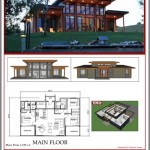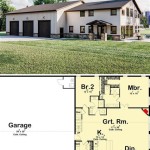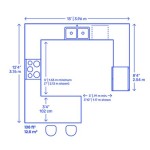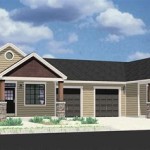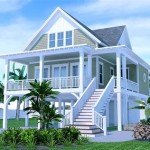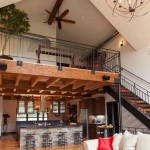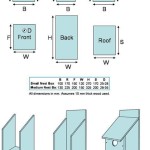Raised Beach Floor Plans: Design Considerations and Benefits
Raised beach floor plans represent a specific architectural response to coastal environments. These designs elevate the main living spaces above ground level, addressing concerns related to flooding, storm surge, and erosion commonly associated with beachfront properties. The fundamental principle involves constructing a building on piers, pilings, or a solid foundation that raises the lowest floor to a designated height, often dictated by local building codes and flood zone regulations. Beyond mitigating environmental risks, raised beach floor plans offer a range of advantages in terms of aesthetics, functionality, and overall property value.
The complexity of designing a raised beach floor plan necessitates a thorough understanding of structural engineering principles, coastal building codes, and the specific characteristics of the site. Careful consideration must be given to the depth and type of foundation required to withstand the forces of wind and water. Material selection is also crucial, with durable and corrosion-resistant materials favored for exposed structural elements. In addition, the design must integrate accessibility features, such as stairs and/or elevators, to ensure ease of use for all occupants.
Key Point 1: Flood Mitigation and Risk Reduction
The primary benefit of a raised beach floor plan lies in its ability to mitigate flood damage. By elevating the living spaces above the base flood elevation (BFE) established by regulatory agencies, the structure is less vulnerable to inundation during storms and high tides. The BFE is a critical reference point, representing the predicted height that floodwaters will reach during a 100-year flood event. Building codes often require that the lowest floor of a structure be elevated above the BFE, with additional freeboard (extra height) mandated in some jurisdictions. Raising the living space above this level reduces the risk of water damage to critical building systems, furniture, and personal belongings. Furthermore, it can significantly lower flood insurance premiums, as the risk of claims is substantially reduced.
The space below the elevated floor, often referred to as the "breakaway" area, is designed to allow floodwaters to pass through unimpeded. This reduces the hydrostatic pressure on the foundation, preventing structural damage. Breakaway walls, typically constructed of lightweight materials, are designed to collapse under the force of floodwaters, minimizing the impact on the main structure. These areas are often used for parking, storage of non-essential items, or recreational space, but they are not intended for habitable use. Proper design and construction of the breakaway area are essential to ensure its functionality and prevent it from becoming a liability during a flood event.
Beyond the immediate benefits of flood mitigation, raised beach floor plans contribute to the long-term resilience of coastal communities. By reducing the vulnerability of individual properties to flood damage, they help to minimize the economic and social disruption caused by storms and other coastal hazards. This is particularly important in areas that are prone to repetitive flooding, where the cumulative cost of damage over time can be substantial. Investing in raised beach floor plans is therefore a proactive measure that can help to protect property values, reduce insurance costs, and enhance the overall sustainability of coastal development.
Key Point 2: Enhanced Views and Optimized Living Space
In addition to their functional benefits, raised beach floor plans offer significant aesthetic advantages. Elevating the living spaces provides expansive views of the surrounding coastal landscape, including the ocean, dunes, and surrounding vegetation. This enhanced visual connection to the environment can significantly improve the quality of life for residents, creating a sense of peace and tranquility. Large windows and balconies are often incorporated into the design to maximize the enjoyment of the views. The elevated perspective also provides increased privacy, as the living spaces are further removed from street level and potential passersby.
The design of raised beach floor plans also allows for the optimization of living space. By placing the main living areas on the upper levels, the ground floor can be utilized for a variety of purposes, such as parking, storage, recreational space, or even additional living quarters. This flexibility allows homeowners to tailor the design to their specific needs and preferences. The elevated living spaces also tend to be brighter and better ventilated, as they are less susceptible to ground-level humidity and shaded conditions. The resulting living environment is often more comfortable and enjoyable, contributing to a higher quality of life for residents.
Furthermore, the elevated design can enhance the spatial flow and connectivity within the home. Open floor plans are often incorporated into raised beach floor plans, creating a sense of spaciousness and allowing for seamless transitions between different living areas. The vertical separation between the ground floor and the upper levels can also create a sense of privacy and seclusion, while still maintaining a connection to the surrounding environment. The combination of enhanced views, optimized living space, and improved spatial flow makes raised beach floor plans an attractive option for those seeking a comfortable and stylish coastal living experience.
Key Point 3: Structural Considerations and Material Selection
The structural design of a raised beach floor plan is a critical aspect that requires careful consideration and expertise. The foundation must be able to withstand the forces of wind, waves, and storm surge, as well as the weight of the structure itself. Common foundation types include pilings, piers, and solid foundations, each with its own advantages and disadvantages depending on the specific site conditions. Pilings, typically made of wood, concrete, or steel, are driven deep into the ground to provide support. Piers are concrete columns that rest on a footing below the frost line. Solid foundations, such as concrete slabs or crawl spaces, are suitable for sites with stable soil conditions and low flood risk.
Material selection is equally important, as the exposed structural elements must be durable and resistant to corrosion. Materials such as pressure-treated lumber, concrete, stainless steel, and fiberglass are commonly used in raised beach floor plan construction. Pressure-treated lumber is resistant to decay and insect infestation, making it suitable for framing and decking. Concrete is a strong and durable material that can withstand the forces of wind and water. Stainless steel is corrosion-resistant and ideal for fasteners and other exposed hardware. Fiberglass is lightweight and strong, making it a good choice for siding and roofing materials.
The design must also account for the potential effects of erosion and scour. Erosion is the gradual loss of soil due to the action of wind and water. Scour is the removal of soil around the foundation due to wave action. Both erosion and scour can undermine the foundation and compromise the structural integrity of the building. To mitigate these risks, erosion control measures, such as seawalls, bulkheads, and vegetation, may be necessary. The foundation should also be designed to resist scour by extending it deep into the ground or by using scour protection measures, such as riprap (a layer of large rocks).
In summary, raised beach floor plans present a well-engineered solution for coastal construction, addressing the inherent challenges of building in such environments. They provide a framework for safer, more attractive, and ultimately more valuable properties in flood-prone areas. The success of such a design hinges on careful planning, adherence to building codes, and the selection of appropriate materials to ensure long-term durability and resilience.

Antioch Raised Beach Home Plan 024d 0542 Search House Plans And More

Coastal House Plans Sdc

Elevated Home Raised House Building Plan Designs

35 Best Raised Coastal House Plans Ideas Beach

Stoney Hill Raised Beach Home Plan 024d 0085 House Plans And More

Elevated Stilt Raised House Plans For Builders

Coastal House Plan Ch672

6 Elevated Beach House Plans For Your Summer Getaway

Eventide Cottage Coastal House Plans From Home

Elevated Piling And Stilt House Plans Coastal From Home
Related Posts

